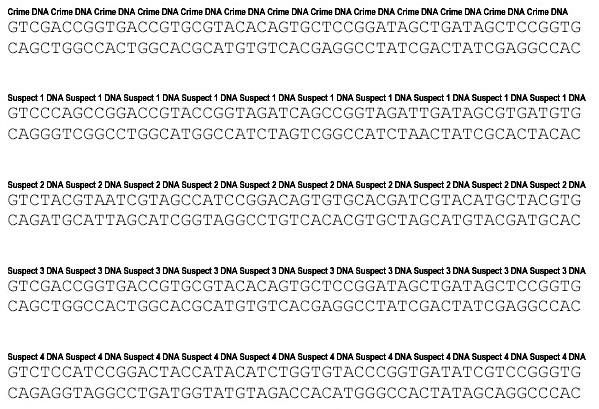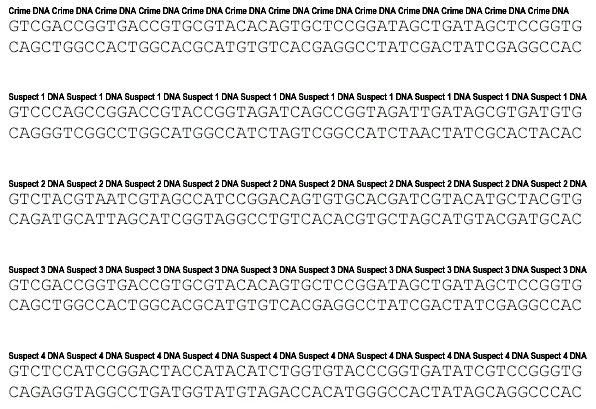DNA Evidence Evaluation
Lab 14 – Who Ate the Cheese?
Objectives: In this simulation you will examine crime scene evidence to determine who is responsible for eating the Queen's special imported Limburger Cheese (yes, the stinky cheese). You will model the process of electrophoresis and DNA fingerprinting.
To begin, please read the Royal Guard Incident Report on page 2, then return to this page and begin the DNA Evidence Evaluation.
DNA Evidence Evaluation
- Look at your DNA sequences sheet with the molecular bases. The restriction enzyme cuts at every point it finds C C G G, always cutting between the C and the G. Use a pencil to simulate the cutting of the DNA sequence by putting a line between the C C and G G points and its base pair below it.
Example:
CTACCGGAT
GATGGCCTA
- Count the number of base pairs in each of the DNA sequences you cut. Record the base pair number below the DNA fragment.
Example:
CTACCGGAT
GATGGCCTA
5 4
- Shade your DNA fragments (sequences) in the Electrophoresis Data Chart, page 3, using the base pair numbers as a guideline for fragment placement.
- Compare the crime scene DNA to the suspects and indicate on your chart, which suspect is guilty of eating the cheese.
Analysis
- On your chart, circle the suspect's DNA who matches the DNA at the crime scene and write the name of the suspect. Support your answer. __
- Identify the procedure used to obtain these results._______________
- Which chemicals are used to cut DNA into fragments for this gel electrophoresis procedure?
|
ROYAL GUARD INCIDENT REPORT | ||||||||||||||||||||||||
|
Incident Data
Property
Burglary Data Method of Entry: Unknown, no evidence of force on doors or windows. Narrative: The cheese was allegedly stolen from the Queen's sitting room the night before the grande ball. The cheese was listed as a gift from the Manchurian diplomat. Officer Li Gase dusted for fingerprints and found none on the table or doors, the maid claimed that they had been wiped clean earlier. The wheel of cheese was on a platform in the sitting room, and half of it had been eaten. We took pictures of the half eaten cheese and sent it to the lab for further tests. Edna N. Zime, the lab technician said that saliva samples could be taken from the teeth imprints of the cheese that was left behind. Suspect Data Suspect Number 1 Suspect Number 2 Suspect Number 3 Suspect Number 4 Crime Lab Data
Narrative: After receiving the package with the plastic bag marked Crime Scene, the DNA was extracted. Because the sample was so small, the DNA was amplified using the polymerase chain reaction. We isolated the DNA from the four suspects and compared them to the crime scene DNA using DNA restriction analysis. Results: See attached DNA Results |
Who Ate the Cheese? Electrophoresis Data Chart
|
Crime DNA |
Suspect 1 |
Suspect 2 |
Suspect 3 |
Suspect 4 |
# of Base Pairs |
|
31 | |||||
|
30 | |||||
|
29 | |||||
|
28 | |||||
|
27 | |||||
|
26 | |||||
|
25 | |||||
|
24 | |||||
|
23 | |||||
|
22 | |||||
|
21 | |||||
|
20 | |||||
|
19 | |||||
|
18 | |||||
|
17 | |||||
|
16 | |||||
|
15 | |||||
|
14 | |||||
|
13 | |||||
|
12 | |||||
|
11 | |||||
|
10 | |||||
|
9 | |||||
|
7 | |||||
|
6 | |||||
|
5 | |||||
|
4 |
DNA Sequences

DNA Sequences



